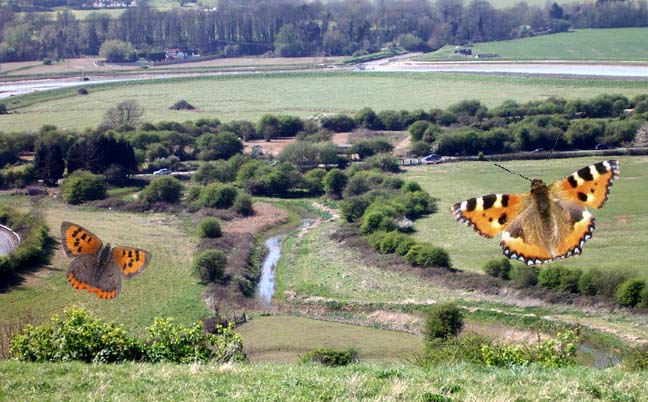

The
narrow field next to the stream by the Steyning Road
(TQ 209 068). It has had various names in
the past including Miller's Stream the then owner of the adjacent
field. It has also been known as Spring Dyke.
7 December
2004
An
unseasonal
12.3 ºC prompted me a visit when I would
normally have thought it not worth the trip, and nothing much moved except
I disturbed a pair of Mallards.
I had to watch my step to avoid a burrow with
a entrance of 25 cm in diameter, too big for a rabbit,
and to avoid stepping on black faeces which I think were from
Fox and
Deer, at a wild guess. The hole, burrow
or den did not smell. It seemed very clean. The Moorhens
seem to have deserted Miller's Stream,
where they were once the noisiest and prevalent feature. There were at
least four distinctive calls from birds hidden in the bushes, but I am
not experienced to put a name to each to these.
 |
 |
 |
 |
 Fungi
is usually the only thing growing of interest in December and it was not
until my departure (by the gate) that I discovered two species. The red-orange
mushroom growing from the reed strewn soil measured 22 cm cap diameter
and it was 44 mm high and this is probably Tubaria
furfuracea
seen last winter
(above far left and second from the left).
The other species (two images above, second
from right to far right, and an image to the right of this text)
looked much smaller, although the measurements of this tall mushroom were
90 mm high and a conical cap diameter of 18 mm, with a smaller specimen
next to it which measured 65 mm high and a brown conical cap that was about
7 mm in diameter. This species came out of the soil and the base of the
stipe was root-like as shown in the photograph on the far right. The smaller
mushroom of the same species had pale cream-fawn-greyish gills that had
not turned black.
Fungi
is usually the only thing growing of interest in December and it was not
until my departure (by the gate) that I discovered two species. The red-orange
mushroom growing from the reed strewn soil measured 22 cm cap diameter
and it was 44 mm high and this is probably Tubaria
furfuracea
seen last winter
(above far left and second from the left).
The other species (two images above, second
from right to far right, and an image to the right of this text)
looked much smaller, although the measurements of this tall mushroom were
90 mm high and a conical cap diameter of 18 mm, with a smaller specimen
next to it which measured 65 mm high and a brown conical cap that was about
7 mm in diameter. This species came out of the soil and the base of the
stipe was root-like as shown in the photograph on the far right. The smaller
mushroom of the same species had pale cream-fawn-greyish gills that had
not turned black.
Tubaria
furfuracea certainly looks likely.
The
other one is a Psathyrella
- if it is rooting it's Psathyrella
microrhiza, but rooting refers to
a small tap root, not lots of little white rootlets (which would be called
"strigose"). Must dig up carefully and then usually need to cut in half
(vertically) to see if it's rooting. If not rooting, then probably Psathyrella
gracilis. They both start out brown and
dry pale grey to dirty white, but young caps of Psathyrella
microrhiza are richer brown and more parabolic
whereas Psathyrella gracilis
is duller and more conical. Tubaria furfuracea,
Psathyrella
microrhiza and Psathyrella
gracilis all usually grow from sawdust,
although late in the season (i.e. December!)
Tubaria
furfuracea grows on soil - some people
call this another species (Tubaria hiemalis,
I think).
25
November 2004
The
vegetation had been cut down by some large mechanical vehicle and it was
muddy under foot. There was still enough shelter for two male Pheasants
that called before taking flight, followed on a separate occasion by a
female Pheasant.
This was the total of interest. There were clumps of what could have been
deer dung. There were no sign of mushrooms or fungi.
8 October
2004
An
adult Roe Deer was
seen in the narrow overgrown
field next to the stream by the Steyning Road through
the binoculars from the top of Mill Hill.

 3
September 2004
3
September 2004
I
cut through the Bramble
thorns near the gate with my secateurs, but Bindweed and Thistles hampered
me, and when I found a view amongst the Fleabane,
there was nothing of note. I took a photograph of the Crane
Fly, the exact species not yet labelled.
7
August 2004
In
the evening at a time when virtually all the butterflies had gone to roost
and the bramble spikes made progress very difficult, I disturbed a Gatekeeper
Butterfly and one of every small
dark Common Blue Butterflies. These
look like Small Blues
at first because of their colour but their underside is richly spotted
and patterned revealing their true identity. This is worth a note because
of possible confusion.
19
July 2004
The
sudden appearance of a Peacock Butterfly
was a bit if a surprise. It shouldn't have been as there were enough Stinging
Nettles around.
 |
 |
 |
15
July 2004
A
Blue-tailed
Dragonfly and a red
Ruddy
Darter showed. There were a handful of
Small
Skippers as well. They would not stay
still enough for a photograph, but they did appear to be the conventional
Small
Skippers, very orangey and not Essex
Skippers.
Adur
Skippers
2 July
2004
Two
Small
Heath Butterflies were seen for the first
time in the field with Meadow Browns
(4+).
29
June 2004
There
was a Burnet Moth
with a striking blue striped abdomen (below
right). This was originally thought to be
the Narrow-bordered Five-Spot Burnet Moth,
Zygaena
lonicerae.
However, it it was perhaps
even more likely to be a late flyer of the Five-Spot
Burnet Moth, Zygaena
trifolii ssp. palustrella. A
Small
Skipper was also recorded.
ID
Message from Trevor Boyd on UK Leps
Adur
Burnet Moths
Adur
Skippers
 |
 |
Common Darters were the only dragonflies with no damselflies seen.
 21
June 2004
21
June 2004
This
hoverfly
(above left) looks like the bumblebee
mimic Volucella
bombylans var. bombylans seen
hovering around in the field next to the stream
between the Steyning Road (A283)
and
the Waterworks (TQ 209 068).
A couple of Common Darters were present in thistle-overgrown field as well.
At a fraction over two metres high, I thought that this one was the Giant Hogweed, Heracleum mantegazzianum, at least one plant growing amongst the thistles. This huge alien plant can cause an untreatable and unpleasant rash on affected people. The ubiquitous Common Hogweed, Heracleum sphondylium, grows to a height of two metres in favourable conditions, although it is usually much smaller. The rash produced from the sap of the native umbellifer is not so harmful.
In
favour of the identification of the Giant
Hogweed is that these plants have reached
this height in about six months. The Common Hogweed is thought to grow
this fast, but at the time of writing, I have not found details of the
growth rates on these two hogweeds.
Adur
Hogweed Page
The
hogweeds exude a clear watery sap which sensitizes the skin to ultraviolet
radiation. This can result in severe burns to the affected areas resulting
in severe blistering and painful dermatitis. These blisters can develop
into purplish or blackened scars.
Giant
Hogweed Information Page
14
June 2004
There
were a pair of Goldfinches
on the top of a Hawthorn tree.
9 June
2004
The
thistles
were over a metre high and the dull brown-orange dragonfly and looked larger
and flightier than a damselfly and it was an early Ruddy
Darter* (originally misidentified as a Common Darter).
This
is a very early date for the emergence of this dragonfly, but it was photographed.
 |
 |
| 27
May 2004
A handful of Lacewings, Chrysopa perla, rested on the foliage |
14
June 2004
The earliest Ruddy Darter* was first recorded on 9 June 2004 |
27
May 2004
Two
Large
Red Damselflies, Pyrrhosoma
nymphula, were
mating and at least one Blue-tailed Damselfly,
Ischnura
elegans, was
spotted as well.
Adur
Dragonfly Flight Times
 |
This
plant was found in the verge on the opposite (western) side of the
road to the field.
This is the Wood Avens, which is found in my garden. |
26
May 2004
I
was not sure if it it was two or three species of damselfly I was viewing
over the waist high thistles and tall nettles
in the narrow field next to the stream by the Steyning Road (TQ
209 068). The males and females of over 30
Azure
Damselflies, Coenagrion
puella, look appreciably different,
and the head of the females are often black and white. The other species,
the Large Red Damselfly, Pyrrhosoma
nymphula, was the first time I have
seen this common species, although other observers have seen it and it
is usually the first species reported each year.
Pyrrhosoma
nymphula, was the first time I have
seen this common species, although other observers have seen it and it
is usually the first species reported each year.
Adur
Damselflies
and Dragonflies
The
sawfly on the right looks like Arge
cyanocrocea. The larvae are found
on Bramble.
Sawfly
ID by Patrick Roper(RX
Wildlife)on
the
British Insects
Yahoo Group
 |
 |
 |
|
|
|
|
A single
male Green-veined
White Butterfly made a belated appearance.
The Yellow Flag Iris
were flowering by the road and on the banks of the stream as it turned
the corner on its easterly meanderings.
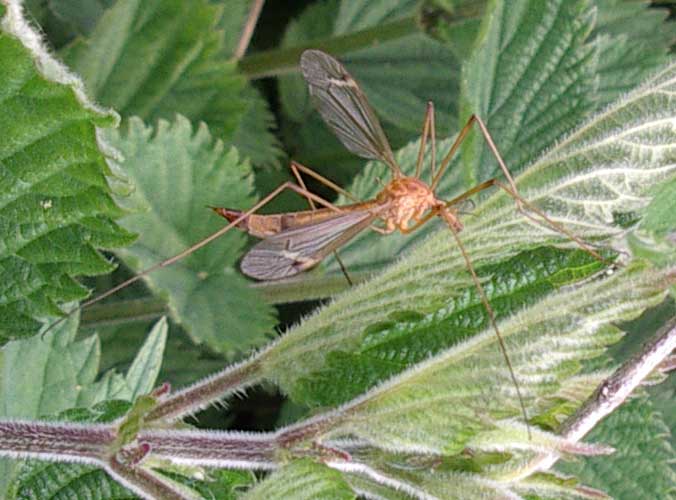 |
 |
 |
|
ID by Malcolm Storey (BioImages) BioImage (Link) |
(either R. scolopacea or R. tringarius) ID by Malcolm Storey BioImage (Link) |
The earlier stages of Small Tortoiseshell caterpillars are much blacker (Image) |
19
May 2004
In
the field between the Waterworks (at Old Shoreham) and the east side of
the Steyning Road, it was really fascinating just how attached the smaller
yellow butterfly was, as a pair of Green-veined
White Butterflies were mating despite
being bothered by other butterflies of the same species and a photographer.
There were about half a dozen in flight, the other four were soloists.
The larger white of the mating pair had very ragged wings. Most books suggest
these are as a result of bird attack but there is the possibility of insect
or small rodent attack as well.
White
Butterflies of Adur
 |
 |
There
were about the same number of Azure Damselflies, Coenagrion
puella, with at least four of them male and these were over the prickly
thistles
and nettles rather than the stream.
British
Dragonfly Society
British
Dragonflies Checklist
Adur
Damselflies
and Dragonflies
Local
Flight Times
27
April 2004
 It
was not until I almost stepped on it that the large
speckled brown bird took to the air with a
flurry as the heavyweight took a second to become airborne from the Creeping
Thistle
and Stinging Nettle in the narrow field next to stream that leads from
the Steyning Road (A283)
to
the Waterworks. Amazingly it was on
my return journey and I could have passed the bird just a few metres away
and still not seen it or disturbed even though the green vegetation would
have scarcely camouflaged it. The flight was a gentle arc and it disappeared
behind some bushes on the southern side of the stream, but it did not appear
to be more than 30 metres away. It did not call. It struggled to get airborne
with a whirring flight like a Partridge, it seemed at least the size of
an Oystercatcher and probably larger, and it was a light fawn and I did
not notice a long beak. It was probably a hen
Pheasant.
It
was not until I almost stepped on it that the large
speckled brown bird took to the air with a
flurry as the heavyweight took a second to become airborne from the Creeping
Thistle
and Stinging Nettle in the narrow field next to stream that leads from
the Steyning Road (A283)
to
the Waterworks. Amazingly it was on
my return journey and I could have passed the bird just a few metres away
and still not seen it or disturbed even though the green vegetation would
have scarcely camouflaged it. The flight was a gentle arc and it disappeared
behind some bushes on the southern side of the stream, but it did not appear
to be more than 30 metres away. It did not call. It struggled to get airborne
with a whirring flight like a Partridge, it seemed at least the size of
an Oystercatcher and probably larger, and it was a light fawn and I did
not notice a long beak. It was probably a hen
Pheasant.

2 April
2004
I
looked into the sheep's field (The Circus
Field) on the Adur
Levels to the direct west of Mill Hill next to the Steyning Road. The
shallow stream was already dry for the second year in succession and there
were no frog spawn or tadpoles
to be seen. Sometimes, tadpoles can be seen in the larger stream between
the Steyning Road (A283) and
the Waterworks (TQ 209 068) but
none were visible, although in their early stages they are difficult to
see amongst the brown algae.
A
pair of Mallards
took
flight. The handful of Small Tortoiseshell
Butterflies were as orange as in the photograph
at the top of the page. The Moorhens were
absent.
10
February 2004
Only
a handful of Tubaria
furfuracea
mushroom remain, although
there were at least two very small fresh fruiting
bodies. A Grey
Heron took off, but there were none of
the usual Moorhens
to be seen.
21
January 2004
The
stream was in flood with a pair of Mallards
and a Grey
Heron taking
off when disturbed. (The usual Moorhens
were absent.) Over a hundred specimens of
the Tubaria furfuracea
mushroom
were growing on their long stems in the long grass amongst the twigs. They
were darker brown-orange than the previous pictures and one of them had
a white dandruffy cap which may have given this species its Latin specific
name.
None of the caps were concave.
Images.

Fungi on the small logs, each less than 10 mm across Stereum
hirsutum comes in lots of different
colours although the shape seems usually about the same.
|
 |
By the gate an the entrance to the narrow field it looked that there was a black cylindrical droppings of a Fox. Sheep were grazing on the field to the north and small fungi were growing on the logs by the double gate.
4 December
2003
 Returning
to the overgrown field to
the west of the Steyning Road north of Old Shoreham and the A27 Flyover
to confirm sizes and small points about the fungi, I saw about 20 small
red/orange cap of the orange species Tubaria
furfuracea with some of them with
a slightly different appearance, slightly paler creamy in colour cap with
just a tinge of orange.
Returning
to the overgrown field to
the west of the Steyning Road north of Old Shoreham and the A27 Flyover
to confirm sizes and small points about the fungi, I saw about 20 small
red/orange cap of the orange species Tubaria
furfuracea with some of them with
a slightly different appearance, slightly paler creamy in colour cap with
just a tinge of orange.
Before
I could raise my camera the lumbering Grey
Herons were airborne, but half a dozen
Mallards
waited for a minute before they took rapidly to the air from the stream
cleared of vegetation.
Fungi
of Shoreham (with more images)
2 December
2003
In
the sombre winter landscape, the bright yellow belly of a Yellowhammer
was
clear and distinctive in the fields to the west of the Steyning Road north
of Old Shoreham and the A27 Flyover. The bird appeared to be feeding on
the grazing land by the stream and then flew into a Hawthorn or similar
tree where it could be seen because all the leaves had fallen.
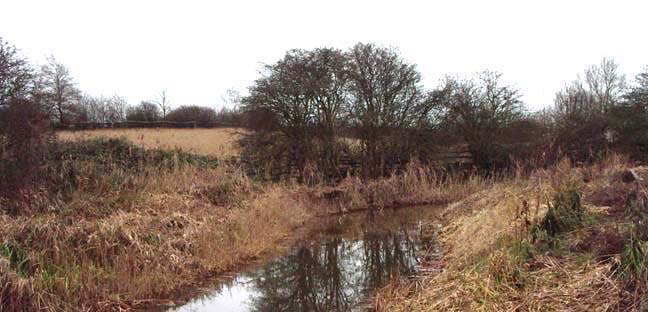
The
vegetation had been cut back on both sides by
the stream.
 |
 |
On the eastern side of the road a pair of Grey Herons took off on my approach. The usual Moorhens were not seen or heard in the afternoon.
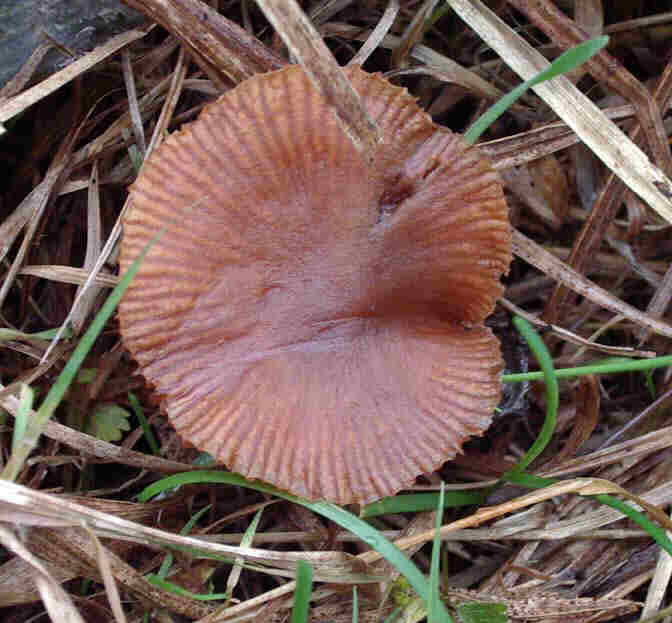 A
small reddish toadstool poked its cap out from amongst the grass and chopped
reeds laid prone to rot on the bank. The cap was under 20 mm across, but
then another larger specimen had a flat cap at 35 mm in diameter. This
species is Tubaria
furfuracea. It is very common on damp
wood fragments or even in rough grassland, especially late in the
season.
A
small reddish toadstool poked its cap out from amongst the grass and chopped
reeds laid prone to rot on the bank. The cap was under 20 mm across, but
then another larger specimen had a flat cap at 35 mm in diameter. This
species is Tubaria
furfuracea. It is very common on damp
wood fragments or even in rough grassland, especially late in the
season.
(Laccaria
laccata has thicker, more distant and more irregular gills and
has been uncommon this season.)
At
the foot of a Hawthorn Tree there was a clump of Coprinus mushrooms.
These are the Glistening Inkcap, Coprinus
micaceus. Against the gate on the eastern side in the sheep grazed
field a couple of logs lay prone. They were covered in small clumps of
the bracket fungi Stereum
hirsutum and unidentified mushrooms.
Fungi
of Shoreham (with more images)
 12
November 2003
12
November 2003
It
was time for this narrow field to be mechanically
shorn of its remaining vegetation. The private field will now become passable
until next summer. The photograph at the top of the page shows the narrow
field by the stream after dense cover has been removed.
3 October
2003
I
disturbed a dozen Wood Pigeons
which were more than usual. The Hawthorn
Trees
were bright red with berries. The Water Mint
was still flowering in places, but all the Fleabane
and Creeping Thistle
had all ceased.
20
September 2003
One
Painted
Lady and one Small
Copper Butterfly were out in the sunshine
in a fleeting visit of a few minutes only. Both
butterflies
preferred to nectar on Fleabane,
which was the most prevalent flower.
 16
September 2003
16
September 2003
The
first Migrant
Hawker Dragonfly, Aeshna
mixta, of
the year is seen through binoculars, hawking to and fro and never settling
over the stream by the Steyning Road (TQ 209
068), just north of the A27 Flyover. It had
a dark blue thorax and a brown head.
Of
the two Small Copper Butterflies,
both attracted to the Fleabane
(to both the yellow flowers and the dead heads), neither of them seemed
to be the two seen before because the slight wing damage was different.
There was at least one Common Blue Butterfly,
an
unidentified White Butterfly,
and
a Red Admiral Butterfly
flying over the Hawthorn Trees.
12
September 2003
An
adult Roe Deer
literally jumped out of the tall thistles its
reddish-brown hide (summer coat) seen very clearly and this was a much
larger deer than I had seen before at relatively close quarters, probably
up to a metre in height (about 75 cm to the shoulders), and there was extensive
rustling nearer the Hawthorn and caught a glimpse of another deer. The
deer did not appear to have antlers but the deer was away in scarcely more
than a second and it was difficult to be sure. This narrow field (TQ
209 068)
has been known (from previous observation)
as a place where deer could rest usually undisturbed in the late afternoon.
My first record was on 14 September 2001, but
they could be stumbled upon in all months of the year. I have never heard
the deer bark and these pair were silent.
8
September 2003
The
narrow field next to the stream by the Steyning Road (TQ
209 068) was still impenetrable after 100
metres because of the Creeping
Thistles, but
there was also Creeping Cinquefoil,
Water
Mint, Fleabane
and Teasel, altogether
the vegetation associated with a neglected pasture that was no longer grazed.
 |
Small Copper Butterfly
This seems to be the habitat favoured by the Small Copper Butterfly and at least two of these small prettily coloured insects landed and remained still (the butterfly on the left has a small nick on its left upper forewing). It looked dainty but chased off what could have been a Common Blue Butterfly.
19
August 2003
The
Green-veined
White Butterfly favoured brief nectaring
on the Willowherb,
Epilobium,
to
Fleabane
and other plants. There are two of these butterflies
confirmed settling simultaneously and probably a few more in the narrow
field next to the stream by the Steyning Road (TQ
209 068).
 |
 |
|
|
|
24
July 2003
 The
Green-veined
White Butterfly and the pale moth with
the book name of Blood Vein, Timandra
comae, were photographed from
this field, but the images were not examined until much later. The moth
caterpillar includes Dock amongst its food plants. (The
name Timandra griseata
used in some books is a mistake and refers to a species not found in the
British Isles. Name information
by John Muggleton via UK
Moths. Click
on this text for spelling of the specific name information.) The correct
scientific name may be Timantra
comai, (this seems not to be official).
The
Green-veined
White Butterfly and the pale moth with
the book name of Blood Vein, Timandra
comae, were photographed from
this field, but the images were not examined until much later. The moth
caterpillar includes Dock amongst its food plants. (The
name Timandra griseata
used in some books is a mistake and refers to a species not found in the
British Isles. Name information
by John Muggleton via UK
Moths. Click
on this text for spelling of the specific name information.) The correct
scientific name may be Timantra
comai, (this seems not to be official).
Checklist
of UK Recorded Geometridae (MapMate)
 19
July 2003
19
July 2003
The
field next to the stream by the Steyning Road (TQ
209 068) was so full of Creeping
Thistles that it was nigh impossible to
transverse without being pricked uncomfortably, even by choosing easier
passage through Fleabane.
At least a dozen Small/Essex Skippers*
flitted around and settled occasionally in the tall vegetation. (* These
were originally identified as Large Skippers
by
mistake.) (These could be Essex Skippers.
No attempt has been made to separate the two very similar species.) There
was a handful of Meadow Brown Butterflies
and at least one Gatekeeper
was
present.
Adur
Butterflies
Adur
Skippers
PS: The skipper in the photograph
on the right is now thought to be an Essex Skipper,
because of the black undertips of the antennae (the tips are all black)
and the partial black membrane on the outside edge of the fore (outer)
wings (the pattern is more extensive on the Small Skipper). In practice,
I do not know if the first ID point is very clear to differentiate and
I do not know if the second one is definitive.
Butterfly
Conservation: Small Skipper
Butterfly
Conservation: Essex Skipper
How
to distinguish the Common Skipper Thymelicus sylvestris from the
Essex Skipper, T. lineola
11
July 2003
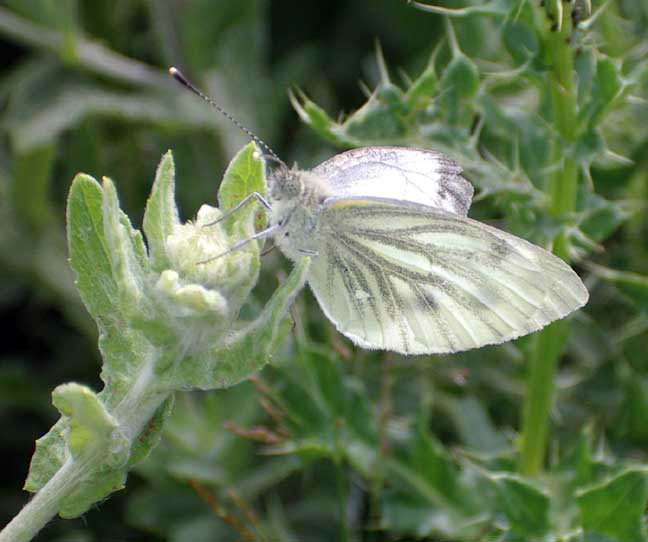 A
bright red Darter Dragonfly was impressive,
but also flighty, avoiding the camera. This was originally thought to be
a Common Darter,
but it is almost certainly a Ruddy Darter.
A Moorhen
clattered up the stream and the incongruous sight was a Great
Spotted Woodpecker overhead, flying for
the nearest tree.
A
bright red Darter Dragonfly was impressive,
but also flighty, avoiding the camera. This was originally thought to be
a Common Darter,
but it is almost certainly a Ruddy Darter.
A Moorhen
clattered up the stream and the incongruous sight was a Great
Spotted Woodpecker overhead, flying for
the nearest tree.
5
July 2003
The
field next to the stream (TQ 209 068) leading
to the Waterworks
(north of Old Shoreham) accessed from the Steyning Road was difficult going
with thistles and nettles. A handful of (Small?)
Skippers, up to a dozen Meadow
Brown Butterflies, a few Red
Admirals, and just one white
butterfly
made an immediate appearance. The black markings
especially on the edge of the wings were particularly marked on this butterfly
which made me think it was a Large
White Butterfly, but subsequent observation
of Large Whites have
now made me identify this butterfly as the Green-veined
White.
 |
 |
But
it was dragonflies that I made the visit for.
There was my first (female) Common Darter,
Sympetrum
striolatum, of the year, possibly the commonest and most widespread
of all the British dragonflies. This was the only dragonfly showing, although
I expect there were more around.
Adur
Dragonflies
Late
June 2003:
21
June 2003
Revisiting
the thistle jungle (TQ
209 068) from a couple of days ago, focused
on photographing the damselflies, and I succeeded in confirming the identity
of the Blue-tailed Damselflies, Ischnura
elegans, (12+)
amongst the Azure
Damselflies, Coenagrion
puella, (12+). I still failed to take a presentable image,
as my
Pentax
330GS digital camera is not really up
to close-up work of flying insects. Notable observations were made of one
Large
Skipper (it did not look particularly large),
a handful of Meadow Brown Butterflies
and a few Small Tortoiseshells.
There was a Cinnabar Moth
plus one Poplar Hawk-moth Laothoe
populi.
British
Dragonflies Checklist
Two caterpillars (illustrated below) were prominent on the tops of leaves, and were discovered on a reed and a Stinging Nettle next to each other.
The first caterpillar identification
is now confirmed.
Top
20 Moths (UK Moths)
The
Peacock
Butterfly caterpillar can be found as
a caterpillar from the end of May
(the
eggs are laid in May) to mid-July and
the adults in flight from the beginning of
August to the middle of May,
but with a lengthy
hibernation period during the colder months.
(Reader's Digest, "Wildlife on your Doorstep" p.93)
What
is the Caterpillar web page
 |
 |
|
|
|
 |
 |
|
Acronicta rumicis |
|
Ecological Habitat Studies
 |
 |
 |
 |
 |
 |
 |
19
June 2003
The
field next to the stream (TQ 209 068) to
the west of the Waterworks (Old Shoreham) was like a jungle with thistles
and nettles. Azure Damselflies, Coenagrion
puella, were common (50+) looked
an extremely bright blue at times and some were black with just a bright
blue tip on their tail.The latter may have been
Blue-tailed
Damselflies, Ischnura
elegans, but these specimens
avoided the camera.
Thistles
of Adur
 |
 |
 |
Azure Damselfly
Click
on the images of the damselflies for a closer look.
Adur
Damselflies & Dragonflies
Links:
List of Dragonfly Sites (left hand column)

A
large bright yellow butterfly (underside) persistently caught my attention
as it fluttered strongly out of photographic range. The upperside was white
with two black marks, so I have identified this as a Large
White Butterfly. Small
Tortoiseshell Butterflies were frequent
(15+) and their caterpillars were observed on nettles. Several young (at
least three) Dark Bush Crickets, Pholidoptera
griseoaptera,
were slow to hide in the
thick vegetation.
MultiMap Aerial Photograph of the Adur Levels and the Downs
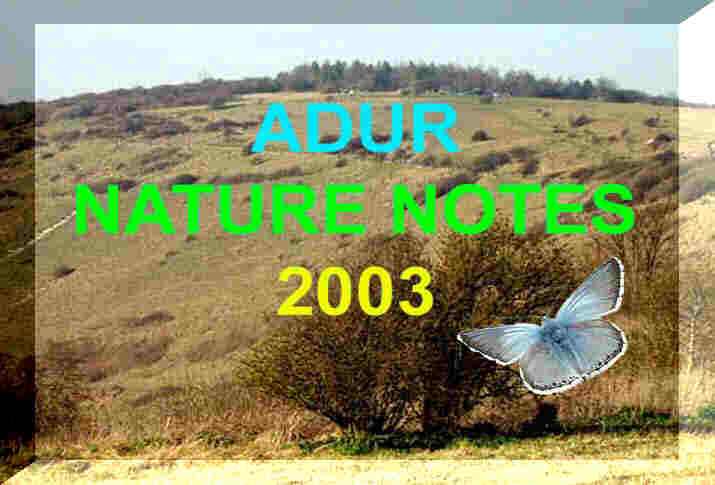 |
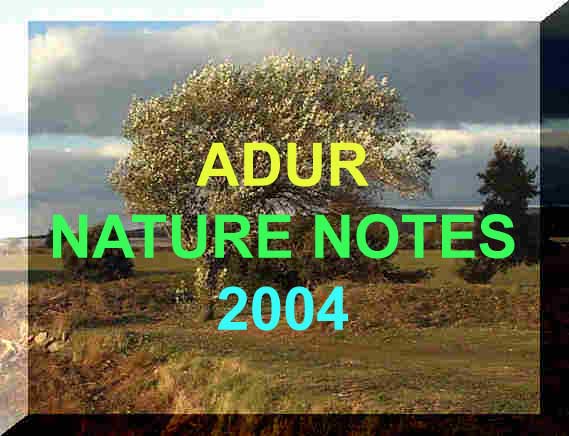 |